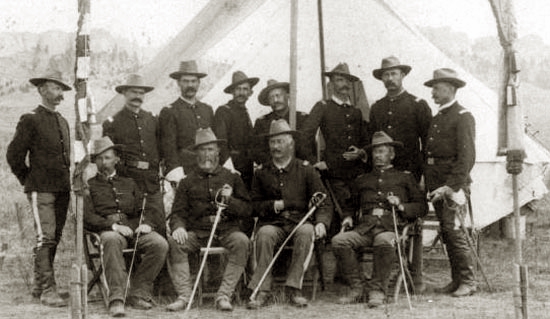Booth, Charles Austin of VermontAppointed from Vermont, Cadet, United States Military Academy, 1 July 1868 (29)
- Second Lieuenant, 7thU. S. Infantry, 14 June 1872
- First Lieutenant, 15 April 1878
- Captain, 19 June 1881
- Major, 6th U. S. Infantry, 15 January 1900
- Transferred to 7th U.S. Infantry, 12 October 1900
- Transferred to the 17th U. S. Infantry, 7 February 1903

Charles Austin Booth (b. October 10, 1850, d. March 03, 1928)
Charles Austin Booth (son of Cyrus Austin Booth and Catharine Mary White) was born October 10, 1850 in Bridport, Vermont, and died March 3, 1928 in Washington, DC. He married Jennie Flora Burge on August 21, 1873, daughter of Howard Hiram Burge and Jane Kibberling Lawrence.
Notes for Charles Austin Booth:Served in the 7th U. S. Cavalry under Major Reno.
LITTLE BIGHORN
In 1874, gold was discovered in the Black Hills, the heart of the new Indian reservation. News of the strike spread quickly, and soon thousands of fortune seekers moved in on the region in violation of the Fort Laramie Treaty. The Army tried to keep them out, but to no avail. The peace agreement in 1868 was dishonored when the Lakota and Cheyenne, in growing defiance, began to leave the reservation. In December 1875, the Commissioner of Indian Affairs ordered them to return before January 31, 1876, or thereafter be regarded as hostiles to be “treated accordingly by the military force.” When the Indians did not comply, the Army was called in to enforce the order.
The Army's campaign against the Lakota and Cheyenne called for three separate expeditions-Gen. George Crook's force from Fort Fetterman in Wyoming, Col. John Gibbon's command from Fort Ellis in Montana and Gen. Alfred H. Terry's troops from Fort Abraham Lincoln in Dakota Territory. These columns were to converge on the main group of Indians concentrated in southeast Montana under the leadership of Sitting Bull, Crazy Horse and other war chiefs.
Crook clashed with the Indians in March and again in June. Later, the Indians moved west toward the Little Bighorn. In mid-June, Terry and Gibbon met at the confluence of the Yellowstone and Rosebud rivers. Hoping to find the Indians in the Little Bighorn Valley, Terry ordered Custer and the 7th Cavalry up the Rosebud to approach the Little Bighorn from the south. Terry himself would accompany Gibbon's force back up the Yellowstone and Bighorn to approach from the north.
The 7th Cavalry, numbering about 600 men, located the Indian camp on June 25. Custer, probably underestimating the fighting power of the Indian forces, believed it safe to divide his regiment into three battalions. By attacking immediately, he probably hoped to prevent the Indians from slipping away. One battalion of three companies under Captain Frederick Benteen was sent to scout the valley to the south. At the same time, a battalion of three companies under Major Marcus Reno and one of five companies under Custer marched along opposite banks of a small creek to attack the Indian village in the valley of the Little Bighorn.
When near the Little Bighorn, Custer turned north toward the lower end of the Indian camp. Reno, with orders from Custer to cross the river and attack, advanced down the Little Bighorn Valley and struck the upper end of the camp. Outflanked by the defending warriors, he retreated in disorder to the river and took up defensive positions on the bluffs beyond. Here he was soon joined by Benteen, who had hurried forward under written order from Custer to “Come on; big village, be quick, bring packs.”
Gunfire from the north caused men to scout in that direction seeking the whereabouts of Custer and his command. An advance company under Captain Thomas Weir marched downstream to a high hill, from which the Little Bighorn battlefield was visible. By this time, however, the firing had stopped. When the rest of the command arrived on the hill, it was attacked by a large force of Indians, and Reno ordered a withdrawal to the original position on the bluffs overlooking the Little Bighorn. Here, these seven companies entrenched and held their defenses throughout that day and most of the next, returning fire and successfully discouraging attempts to storm their position. The siege ended when all the Indians broke their great encampment and withdrew upon the approach of columns under Terry and Gibbon.
In the meantime, Custer had ridden into history and legend. Vivid accounts of the battle by Indians who participated in it tell how his command was surrounded and destroyed in fierce fighting. But Custer's intentions and precise movements after separating from Reno's battalion have never been documented.
In the battle, the 7th Cavalry lost the five companies that were under Custer, about 210 men. Of the other seven companies in the regiment, under Reno and Benteen, 53 were killed and 60 wounded.
The Indian losses were no more than 100 men killed. The tribes and families scattered, some going south, some north. Most of them returned to the reservations and surrendered in the next few years.
More About Charles Austin Booth and Jennie Flora Burge:
Marriage: August 21, 1873
Children of Charles Austin Booth and Jennie Flora Burge are:
+Catharine Flora Booth, b. February 22, 1878, Fort Shaw, Cascade, Montana, d. date unknown, Pultneyville, NY
BOOTH, CHARLES AUSTIN
- United States Army
- DATE OF DEATH: 03/03/1928
- BURIED AT: SECTION 1 SITE 464-WS
- ARLINGTON NATIONAL CEMETERY
BOOTH, JENNIE FLORA BURGE
- DATE OF DEATH: 10/27/1923
- BURIED AT: SECTION 1 SITE 464-ES
- ARLINGTON NATIONAL CEMETERY
Michael Robert Patterson was born in Arlington and is the son of a former officer of the US Army. So it was no wonder that sooner or later his interests drew him to American history and especially to American military history. Many of his articles can be found on renowned portals like the New York Times, Washingtonpost or Wikipedia.
Reviewed by: Michael Howard
